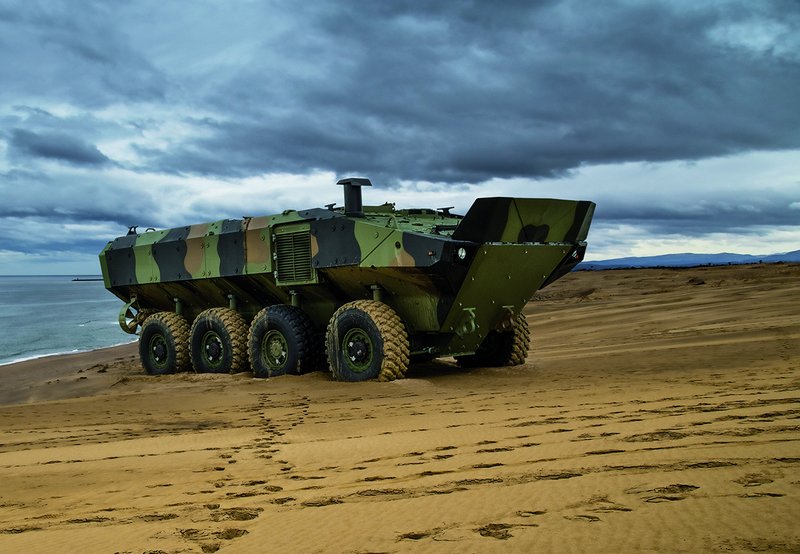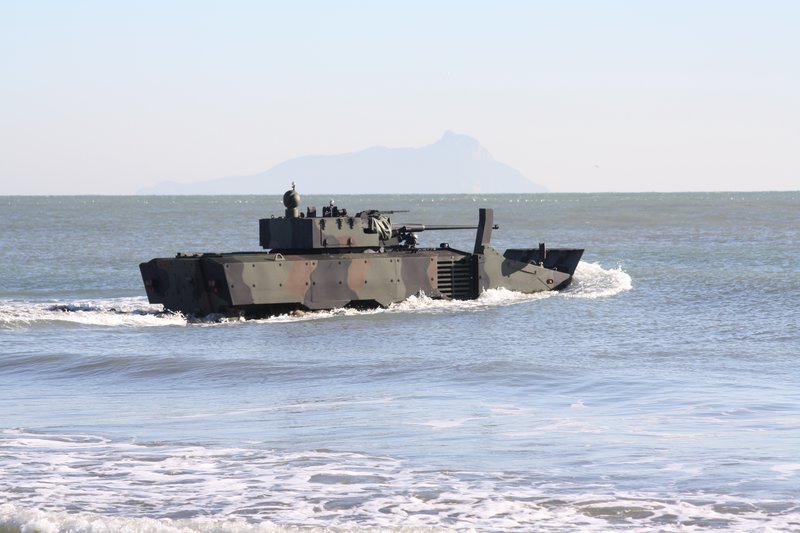Italy refreshes amphibious armour with first VBA 8x8 due in 2025
The Italian Navy will receive the first of 36 IDV Veicolo Blindato Anfibio (VBA) 8x8 amphibious vehicles for its Brindisi-based San Marco Marine Brigade in 2025, with final deliveries in 2030.
The VBAs on order will replace the BAE Systems tracked Assault Amphibious Vehicle (AAV-7A1)... Continues below
Newsletter Sponsors:

Above: A VBA 8x8 APC without weapon system is seen leaving the water, showing the trim vane at the front of the hull and extended snorkel. (Photo: IDV)
In future, the Italian Army is also expected to procure the VBA to replace its own AAV-7A1 fleet used by the Lagunari Regiment ‘Serenissma’, with about 82 required.
Production of the VBA is undertaken at IDV’s facility in Bolzano, as the programme does not fall under the Consorzio Iveco-Oto Melara (CIO), which handles most tracked and wheeled AFVs for the Italian Army including the in-production Centauro II mobile gun system and Freccia IFV.

Explore armored vehicles and turret systems of Otokar, the global land systems manufacturer.
Italian Navy VBAs will be fitted with the Leonardo Hitrole RWS armed with a stabilised 12.7mm machine gun.
This is not supplied as government-furnished equipment and is procured from Leonardo in La Spezia. Hitrole is fitted to many other Italian armoured platforms including IDV’s Light Multi-role Vehicle.
For export, other armament options can be fitted to the VBA, such as the Leonardo Overhead Weapon Station (OWS) armed with a 30mm cannon and 7.62mm coaxial MG, with the option of a pod of two Spike-LR antitank missiles on the right side of the turret.
The baseline VBA has a crew of three (commander, gunner and driver) and can carry up to ten dismounts, depending on the user’s requirements.
While the first version for Italy is in APC configuration, it is expected that in future more specialised variants will be procured including a combat model fitted with an uncrewed turret and 30mm cannon, command posts, armoured recovery vehicles and mortar carriers.
The VBA is fully amphibious and for in-water operation all that is required is to push a few buttons to extend the trim vane at the front of the hull, activate the bilge pumps and extend the snorkel.

When afloat it is driven by two independent propellers mounted on either side under the rear hull, driven from a power take-off from the gearbox, and allowing a maximum water speed of 6kts.
According to IDV the VBA can safely operate in Sea State 3 and therefore carry out ship-to-shore operations.
The power pack is an Iveco Cursor 16 turbocharged and intercooled diesel developing 700hp coupled to an Allison 4800 SP automatic transmission, giving a maximum road speed of up to 105km/h.

Above: A VBA fitted with a Leonardo Overhead Weapon Station armed with 30mm cannon and 7.62mm coaxial MG, showing the roof-mounted panoramic sight. (Photo: IDV)
Another development of the baseline SuperAV 8x8 design is in production by BAE Systems in the US as the Amphibious Combat Vehicle (ACV) with over 200 built; for this IDV supplies a number of subsystems including the complete power pack, driveline, protection elements and seats.
A number of other potential customers exist for the VBA/ACV, including the Spanish Marine Infantry which operates a fleet of AAV7A1s that needs replacement.
Other articles in this newsletter:
Securing the shoreline – why coastal defence is back on the agenda
Alakran mortar maker NGTS branches out to produce own ammunition
IDV and BAE Systems are jointly marketing the design to armed forces that currently operate the AAV7A1 and other amphibious vehicles.
Prior to being ordered by Italy, the original SuperAV was developed by IDV using internal R&D funding, with three vehicles built with increasing performance and capabilities.
IDV is also marketing SuperAV Land, which is more compact as it does not have an amphibious capability. The gross vehicle weight can be up to 31,500kg of which 5,400kg is payload, allowing installation of heavier weapons.
Don't want to miss out on future Decisive Edge content? Make sure you are signed up to our email newsletters.












